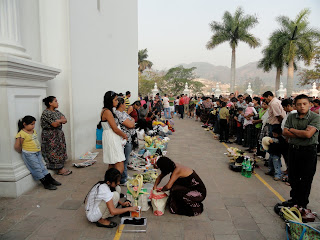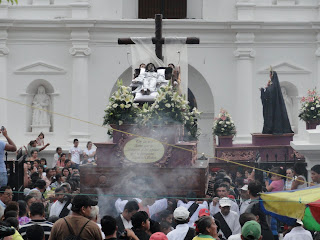Cristo Negro, the statue for which Esquipulas is famous, is known for being a miracle maker and some Esquipultecan must have put an especially fervent petition to him at the beginning of the drought because right as the pilgrims hit their peak numbers the skies clouded over for the first time in months. Not 24 hours after the Abbot asked us to save water and people began worrying about the accumulating pilgrim filth and no water to clean it up the skies opened with the first substantial rain of 2011. A whole month before the rains typically fall! The streets got cleaned and the tanks got full, but Cristo Negro wasn't done giving. It rained for the entire Holy Week! Between drizzle (Chipi Chipi) and full on thunderstorms, the earth got the water it desperately needed, and the sun didn't come out until the Monday after Easter.
While the rain was a blessing for the people of Esquipulas who rely largely on water to stay alive, it was pretty unfortunate for the pilgrims. These pilrgims generally come to Esquipulas expecting to buy all their drinking water, not to bathe and, given that it is usually pretty dry here, not to get rained on. Therefore, when the water tanks ran dry they didn’t particularly notice, but when it started raining they definitely did. The rain put a damper on the spirits of the pilgrims, and the grey skies took a bit of a toll on me. Added to the fact that I had gotten into an argument the on Tuesday with a table full of monks, some of whom were not to happy with me even a few days afterward, I was in a pretty somber mood for most of Holy Week (the topic was whether we can have free will and God can be omniscient). However, Holy week waits for no man and, somber mood or not, I wasn't going to miss the activities.
The week started with Palm Sunday, which brought a nice ceremony to open the week. The thing that really stuck out to me was the difference between the palms they use here and the ones we have back in the United States. While we generally opt for the plain palms, at most braided or folded into a cross shape, down here the tradition is a little more glitzy.
Palm Sunday also brought the first wave of pilgrims, a very prayerful and orderly group. Definitely the most organized of the groups of pilgrims we've had.
This is generally complete chaos
These tranquil and prayerful pilgrims didn’t do much to build the spirit of fiesta I expected, and the beginning of Holy Week that followed Palm Sunday was pretty quiet as well. A somber moment did come on Wednesday as a dominant Barcelona soccer team lost the "Copa del Rey" to Real Madrid (followed by a hilarious moment as Sergio Ramos dropped the cup under a bus during the post game celebrations).
The Easter celebrations and traditions really kicked off Thursday for the mass of the last supper. By this time the falling rain was beginning to put a damper on the carnival activities, but the shops were able to throw up tarps and there was an expectant and excited air for the beginning the Easter triduum. The Basilica filled with people, the line for Cristo Negro swelled, and I was introduced to a new Guatemalan tradition: the procession. Processions are a popular tradition around Easter time consisting of people hoisting large shrines related to the day (Christ alive, crucified, dead, and risen) and marching them around town to a following chorus of songs and prayers. It was a very unique experience for me, and a fresh take on prayers that is very special for the people here. Over the Easter season these procession quickly became one of my favorite of Guatemala’s traditions.
The Easter celebrations and traditions really kicked off Thursday for the mass of the last supper. By this time the falling rain was beginning to put a damper on the carnival activities, but the shops were able to throw up tarps and there was an expectant and excited air for the beginning the Easter triduum. The Basilica filled with people, the line for Cristo Negro swelled, and I was introduced to a new Guatemalan tradition: the procession. Processions are a popular tradition around Easter time consisting of people hoisting large shrines related to the day (Christ alive, crucified, dead, and risen) and marching them around town to a following chorus of songs and prayers. It was a very unique experience for me, and a fresh take on prayers that is very special for the people here. Over the Easter season these procession quickly became one of my favorite of Guatemala’s traditions.
The Holy Thursday procession was probably the smallest of the Easter processions as everyone was looking forward to the bigger celebrations of the death and resurrection of Jesus.
Good Friday was the biggest day for pilgrims in the Basilica but due to the weather and the somber remembrances of the day,the feeling of festival that I remembered from January 15th was still missing. Realizing that the party was not to be had at the Basilica I made my way to the Parish to partake in the procession. This was the biggest one I saw and it was really a beautiful ceremony. It started with Liturgy of the Word and a mock crucifixion of a statue of Jesus at 3:00pm. At 4:00 they removed Jesus from the cross and put him on the processional shrine. A little while later (things rarely start on time here) the procession started moving. It was really beautiful to see the devotion of these people as they carried this heavy shrine on their shoulders.
Good Friday was the biggest day for pilgrims in the Basilica but due to the weather and the somber remembrances of the day,the feeling of festival that I remembered from January 15th was still missing. Realizing that the party was not to be had at the Basilica I made my way to the Parish to partake in the procession. This was the biggest one I saw and it was really a beautiful ceremony. It started with Liturgy of the Word and a mock crucifixion of a statue of Jesus at 3:00pm. At 4:00 they removed Jesus from the cross and put him on the processional shrine. A little while later (things rarely start on time here) the procession started moving. It was really beautiful to see the devotion of these people as they carried this heavy shrine on their shoulders.
About 5 minutes after the procession started, so did the rain and, although the rain did not deter the processing people, it definitely deterred my electronic camera and me, and we quickly beat our retreat back to the Basilica.
The rain continued on and off through the night and into Saturday when it let up a little towards evening. By this point I had become a bit of a procession fanatic and the word on the street was that the biggest procession was to start Saturday night at midnight and continue until sunrise on Easter Sunday. With the rain letting up I had high hopes that I would be able to attend the all night procession. However, due to the rain most of the pilgrims had left early leaving the basilica and the park empty, cutting off my ability to return home if rain started. I was still considering risking it when I went to the carnival with a friend and we got poured on. With my hopes dashed I decided to play it safe, stay in, and make do with the 4:30 am Easter Vigil service at the Basilica. As we started the (3 hour) vigil, the procession passed by the Basilica, still going strong, still singing and celebrating, completely dry.
The Easter holiday went out with a whimper with the street vendors and pilgrims who were brave enough to stick around through Sunday packing up and heading home. The drizzle and rain continued throughout Sunday, which made for great napping weather as I stayed out late then got up at 4:00 for a 3 hour mass. As the last of the vendors hit the road the sun came finally came out, making for a beautiful end to the Easter Sunday.
The wonderfully cool and cloudy weather that we had for Easter went with the pilgrims and the next week returned to the hot and sunny weather normal for this time of year. However the rain left me with a present that I spent all week dealing with: Amoebas. Here they call it the “mal de mayo,” and what it is is a resurgence of bacteria that come with the first rains after the long dry season. With the amoebas and the heat the week was a long and lazy one lacking Easter spirit. However, by the weekend I was feeling good again and so were the people of Esquipulas who finally got into a fiesta mood for the beatification of pope John Paul II. On Sunday most of Esquipulas made their way to valle de maria which is where JPII held mass when he came here in 1996. We all bought the white t-shirts with his face on them, and celebrated a mass in his honor. After a nice service the skies clouded over once more. As the final blessing of the mass was given the rain came. Because there is only one road into the valley, a massive, soaking wet traffic jam started. With most people on motorcycles, and everybody wearing the white t-shirts, the Pope John Paul II memorial mass quickly turned into the Pope John Paul II wet t-shirt contest. I have a feeling that someone made a pretty fervent prayer for this rain as well.



















































